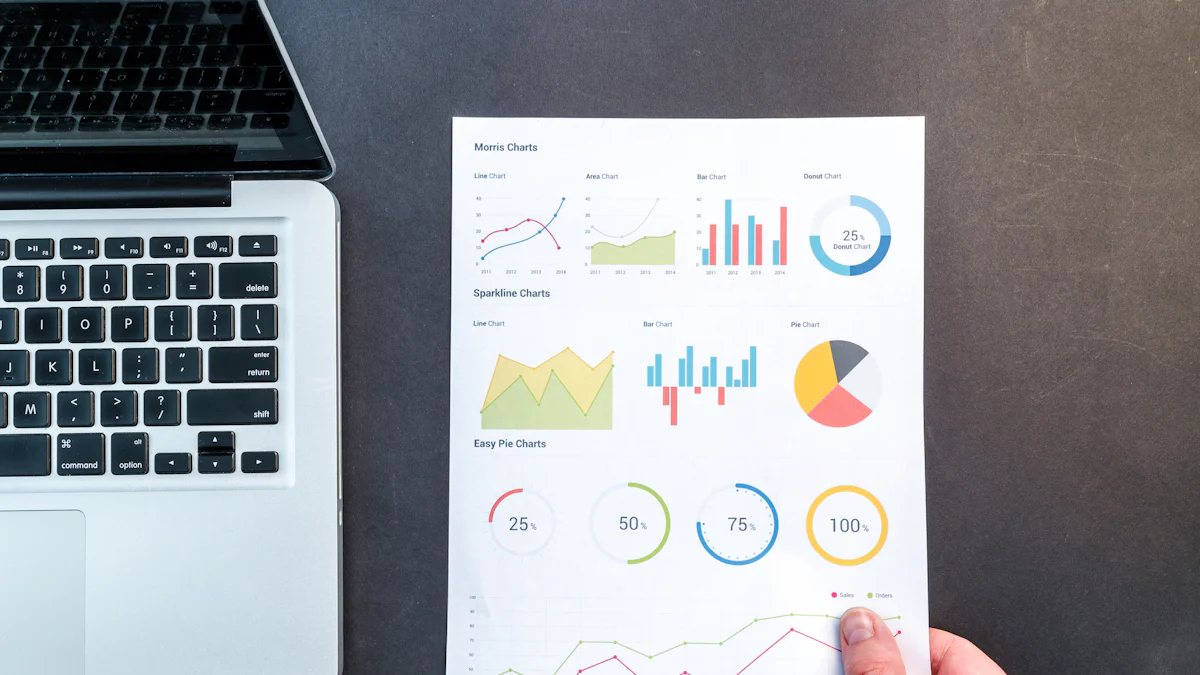Measuring Influencer Marketing ROI Made Easy in 2025

Influencer marketing ROI measures the return on investment from your influencer campaigns. In 2025, this metric has become more critical than ever as the industry grows rapidly. Did you know influencer marketing has expanded into a $21.1 billion industry, up from just $1.7 billion in 2016? With brands allocating over 40% of their marketing budgets to influencers, knowing how to measure influencer marketing ROI ensures your resources are spent wisely. It helps you track campaign success, adjust budgets, and make data-driven decisions that drive sustainable growth.
Understanding Influencer Marketing ROI
What is Influencer Marketing ROI?
Influencer marketing ROI measures the financial return you get from your influencer campaigns. It’s a way to see if the money you spend on influencers is actually paying off. By comparing the costs of your campaigns to the revenue or other valuable outcomes they generate, you can determine their success. The formula is simple:
ROI = (Revenue Generated - Cost of Campaign) / Cost of Campaign x 100%
This calculation helps you justify your marketing spend and optimize future campaigns. It also identifies which influencers perform best and guides your budget allocation. Plus, it demonstrates the value of influencer marketing to stakeholders. In short, it’s your go-to tool for making smarter decisions.
Why Measuring Influencer Marketing ROI Matters in 2025
In 2025, measuring influencer marketing ROI is more important than ever. Why? Because it helps you allocate your budget effectively. You’ll know which influencers and platforms deliver the best results. It also highlights areas where your campaigns need improvement. Tracking ROI trends lets you adjust your strategy and focus on what works.
Another big reason is proving value. Stakeholders want to see the financial impact of influencer campaigns. ROI analysis gives you the data to back up your decisions. It also helps you evaluate if an influencer is the right fit for your brand. A high ROI means their content resonates with your audience.
Types of Influencer Marketing ROI
Direct ROI (e.g., sales, leads)
Direct ROI focuses on the immediate financial impact of your campaigns. It’s all about numbers—sales, return on ad spend, and cost per acquisition. For example, if an influencer promotes your product and you see a spike in sales, that’s direct ROI. It’s easy to measure and gives you clear results.
Indirect ROI (e.g., brand awareness, engagement)
Indirect ROI looks at the long-term benefits. It’s harder to measure but just as important. Metrics like brand awareness, customer engagement, and loyalty fall under this category. For instance, if your campaign boosts mentions on social media or increases interactions with your content, that’s indirect ROI. These insights show how your brand is growing over time.
How to Measure Influencer Marketing ROI

The ROI Formula
The formula for calculating influencer marketing ROI is straightforward. It helps you determine if your campaign is delivering value. Here’s the formula:
ROI = (Revenue - Cost) / Cost x 100
To break it down further, here are the key components:
| Component | Description |
|---|---|
| Total Revenue | The total income generated from the influencer marketing campaign. |
| Total Costs | The total expenses incurred, including advertising, content creation, and management fees. |
| ROI Calculation | (Total Revenue – Total Costs) / Total Costs) x 100 = ROI (as a percentage) |
This formula gives you a percentage that shows how much return you’re getting for every dollar spent. It’s a simple yet powerful way to measure influencer marketing ROI.
Tools to Calculate Influencer Marketing ROI
In 2025, you have access to advanced tools that make it easier to calculate influencer marketing ROI. These tools help you track performance and attribute results accurately. Here are some of the most effective ones:
- Analytics Tools: Platforms like Favikon provide real-time tracking of key metrics across social media.
- Custom Tracking Links: Unique links let you attribute traffic and conversions directly to specific campaigns.
- Influencer Marketing ROI Calculators: Tools like inBeat’s calculator estimate reach, engagement, and impressions based on your campaign budget.
- Favikon’s Campaign Tracking: This tool uses AI-powered insights to measure impressions, conversions, and more.
These tools simplify the process of measuring influencer marketing ROI and give you actionable insights to optimize your campaigns.
Examples of Calculating Influencer Marketing ROI
Example 1: Direct Sales Campaign
Let’s say you run a campaign with a $500 budget, and it generates $2,000 in sales. Using the formula:
- ROI Calculation: (2000 - 500) / 500 = 3
- Result: 300% ROI
If you account for organic sales growth of $500 and campaign costs of $400, the calculation changes:
- ROI Calculation: (2000 - 500 - 400) / 400 = 2.75
- Result: 275% ROI
This example shows how to measure influencer marketing ROI for direct sales campaigns effectively.
Example 2: Brand Awareness Campaign
For brand awareness, you’ll focus on metrics like reach, impressions, and engagement. Here’s how you can track ROI:
- Direct Traffic: Monitor how many visitors come directly to your website.
- Search Volume: Check if branded keyword searches increase after the campaign.
- Social Engagement: Measure likes, shares, and comments to gauge audience interest.
- Social Listening: Use tools to track brand mentions and public perception.
These metrics help you calculate ROI for campaigns that aim to boost visibility rather than direct sales.
Pro Tip: Always align your campaign goals with the metrics you track. This ensures you’re measuring influencer marketing ROI accurately and focusing on what matters most.
Key Metrics for Measuring Influencer Marketing ROI
Engagement Metrics
Likes, comments, shares
When it comes to measuring influencer marketing success, likes, comments, and shares are the bread and butter of engagement metrics. These interactions show how well your audience connects with the content. A high number of likes and comments means the influencer's message is resonating. Shares, on the other hand, amplify your brand's reach by exposing it to new audiences. By tracking these metrics, you can see if your campaign is sparking interest and excitement among your target audience.
Click-through rates (CTR)
Click-through rates (CTR) are another essential metric. They measure how many people clicked on a link in the influencer's post compared to how many saw it. A high CTR indicates that the content is compelling enough to drive action. For example, if an influencer shares a link to your product page and many users click on it, you know the campaign is working. CTR helps you understand how effectively the influencer is driving traffic to your website or landing page.
Conversion Metrics
Sales generated
Sales generated is one of the most direct ways to measure ROI. It tells you how much revenue your campaign brought in. For instance, if an influencer promotes your product and you see a spike in purchases, that’s a clear win. Tracking sales lets you tie your marketing efforts directly to financial outcomes, making it easier to justify your investment.
Cost per acquisition (CPA)
Cost per acquisition (CPA) measures how much you spend to gain a new customer. It’s a critical metric for understanding the efficiency of your campaigns. Lower CPA means you’re acquiring customers at a lower cost, which boosts profitability. By keeping an eye on CPA, you can align your marketing spend with your financial goals and achieve a higher influencer marketing ROI.
Brand Awareness Metrics
Reach and impressions
Reach and impressions are vital for gauging how many people saw your campaign. Reach refers to the number of unique users who viewed your content, while impressions count the total number of times it was displayed. Tools like Instagram Insights or TikTok Analytics make it easy to track these metrics. They help you understand the scale of your campaign and its potential impact on brand visibility.
Follower growth
Follower growth is another key indicator of brand awareness. If your campaign leads to a noticeable increase in followers, it’s a sign that people are interested in your brand. More followers mean a larger audience for future campaigns, which can lead to even greater success. By monitoring follower growth, you can measure the long-term impact of your influencer marketing efforts.
Pro Tip: Always align your campaign goals with the metrics you track. This ensures you’re focusing on what matters most and achieving a higher influencer marketing ROI.
Actionable Tips to Improve Influencer Marketing ROI in 2025

Choose the Right Influencers
Align with your target audience
Finding the right influencers is the first step to running effective influencer campaigns. You need to ensure the influencer’s audience matches your target demographic. Look for creators who align with your brand values and can authentically represent your message. A good fit will help you prioritize content authenticity, which is key to building trust with your audience.
Here’s how you can identify the perfect match:
- Conduct manual searches on social media platforms.
- Use hashtags relevant to your industry.
- Review influencers’ posts to assess engagement quality.
- Leverage third-party tools to filter influencers by metrics like audience size and sentiment.
Evaluate past performance and engagement rates
Before partnering with an influencer, take a close look at their track record. High engagement rates often indicate that their content resonates with their audience. This can lead to better customer retention and loyalty for your brand. By analyzing past performance, you can make data-driven decisions about which influencers are likely to deliver a good ROI on influencer marketing.
Leverage Tracking Tools
Use UTM parameters for tracking
UTM parameters are a game-changer for tracking influencer marketing campaigns. By adding these tags to your URLs, you can pinpoint which influencers drive the most traffic and conversions. Here’s how to use them effectively:
- Define UTM parameters like source, medium, and campaign name.
- Generate UTM-tagged URLs using online tools.
- Share these links with influencers.
- Monitor performance through analytics platforms.
This approach helps you track campaign effectiveness and make data-driven decisions to improve campaign ROI.
Invest in AI-powered analytics tools
AI-powered tools simplify the process of measuring influencer marketing KPIs. They provide real-time insights, allowing you to fine-tune your marketing strategies. These tools also help you identify areas for improvement, ensuring you drive higher ROI from influencer marketing. Plus, they foster innovation by demonstrating tangible benefits, making it easier to scale your efforts.
Repurpose Influencer Content
Use content across multiple channels
Don’t let great content go to waste! Repurpose influencer-generated content across your social media, email campaigns, and even ads. For example, you can optimize content for different platforms by adjusting image sizes or captions. This strategy not only saves time but also amplifies your reach.
Extend the lifespan of campaigns
To maximize the impact of your influencer marketing campaigns, focus on long-term strategies. Whitelisting influencer content allows you to promote it as ads, extending its reach and providing valuable performance metrics. Longer partnerships with influencers also help build brand loyalty and authority, ensuring a good ROI on influencer marketing over time.
Pro Tip: Always track performance metrics like engagement and conversions to refine your approach and drive higher ROI from influencer marketing.
Build Long-Term Partnerships
Foster authentic collaborations
Building long-term partnerships with influencers starts with authenticity. When you collaborate with influencers who genuinely align with your brand, the results feel natural and relatable. This connection resonates with their audience, leading to higher engagement and stronger brand loyalty. Did you know that 63% of people trust what influencers say about a brand more than what the brand says about itself? That’s the power of authenticity in action.
To foster these collaborations, focus on creating genuine relationships. Treat influencers as partners, not just marketing tools. Share your brand’s story, values, and goals with them. This transparency helps them craft content that feels real and connects with their followers. According to FNBO, influencers are one of the best sources of endorsement because their audiences listen to them. By building authentic connections, you’re not just creating campaigns—you’re building trust with both the influencer and their audience.
Strengthen trust with influencers
Trust is the foundation of any successful partnership. When you work with influencers over time, you create opportunities for honest communication and mutual understanding. This steady relationship allows influencers to provide valuable feedback, helping you refine your campaigns. It also leads to better creative flow, as influencers become more familiar with your brand and can offer innovative ideas.
Transparency plays a big role here. Be upfront about your expectations, goals, and compensation. This openness fosters integrity and strengthens the bond between you and the influencer. Plus, consistent partnerships lead to more stability for your brand. Influencers who regularly advocate for your products build credibility and loyalty among their followers. Over time, this trust translates into higher engagement, better campaign forecasts, and even increased sales.
Pro Tip: Long-term collaborations don’t just benefit your brand—they also empower influencers to create their best work.
Measuring influencer marketing ROI in 2025 is essential for staying ahead in a competitive market. It helps you understand what works, optimize your campaigns, and make smarter decisions. Whether you're tracking engagement rates, conversions, or brand sentiment, these metrics give you a clear picture of your campaign's success.
Here’s a quick recap of key metrics to focus on:
| Metric | Description |
|---|---|
| Engagement Rate | Likes, comments, shares, and saves on influencer content |
| Reach and Impressions | Number of unique users who saw the content and total views |
| Click-through Rate | Percentage of viewers who clicked on links in the influencer's content |
| Conversions | Sales, sign-ups, or other desired actions resulting from the campaign |
| Brand Sentiment | Changes in audience perception of the brand |
By implementing strategies like choosing the right influencers, leveraging AI-powered tools, and repurposing content, you can boost your customer engagement ROI and maximize your return on investment. These steps not only improve campaign performance but also build long-term brand loyalty.
Now it’s your turn! Start applying these tips to your campaigns and watch your results soar.
FAQ
How do you choose the right influencer for your campaign?
Look for influencers whose audience matches your target demographic. Check their engagement rates and past campaign performance. Tools like influencer marketing platforms can help you analyze their reach and authenticity. Always prioritize influencers who align with your brand values and voice.
What’s the best way to track influencer marketing ROI?
Use tools like Google Analytics or UTM parameters to track conversions and traffic. AI-powered analytics platforms simplify ROI measurement by providing real-time insights. Focus on metrics like sales, audience engagement, and reach to evaluate your campaign’s success.
Can indirect ROI be as valuable as direct ROI?
Absolutely! Indirect ROI, like increased brand awareness or audience engagement, builds long-term value. It strengthens your brand’s presence and fosters customer loyalty. While harder to measure, it’s crucial for sustainable growth and complements direct ROI metrics like sales.
How can you improve ROI for influencer campaigns?
Repurpose influencer content across multiple channels to maximize its impact. Use tracking tools to monitor performance and adjust strategies. Building long-term partnerships with influencers also boosts authenticity and trust, leading to better audience engagement and higher ROI.
What metrics should you prioritize for audience engagement?
Focus on likes, comments, shares, and click-through rates. These metrics show how well your audience connects with the content. High engagement indicates that the influencer’s message resonates, driving better results for your campaign.
See Also
5 Essential Steps for Calculating Influencer Marketing ROI
Proven Techniques to Enhance Influencer Marketing ROI This Year
Best Influencer Analytics Tools to Check Out in 2025
